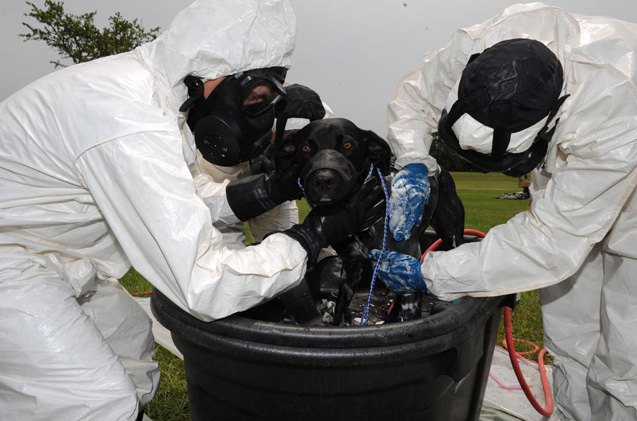New Disaster Procedures Now Include Decontaminating Canines

Veterinarians and animal care specialists from Ford Hood, Texas, have spent a week working on establishing effective decontamination techniques when it comes to dogs in the military such as search and rescue dogs.
“The concept has been discussed at echelons above us,” Lieutenant Colonel Carl Shaia explained. “It is the mechanics that have not been well established.”
Detachment members trained alongside experts from the Texas A&M University (TAMU) on May 9 to 14, learning how to decontaminate response dogs as well as family pets who have been contaminated chemically, biologically, or radiologically.
Related: Heroic Dog Dues After Saving 7 People in Ecuador Earthquake Aftermath
On June 4, the 43rd Veterinary Detachment will assume a first responder mission should a biological, chemical, radiological, or nuclear accident happens anywhere in the United States. The army will also be counting on this detachment’s soldiers to become the technical experts when it comes to providing animal medical care.
“It is very important to me to know what right looks like before assuming the (chemical response) mission,” Shaia said. “My concern was how to become experts. We’re very fortunate that TAMU is the tip of the spear with response effort.”
The Veterinary Emergency Team was formed in 2009 at the request of Texas state officials after Hurricane Ike. It is made up of TAMU veterinary school staff members as well as volunteer vets from around the state. Dr. Deb Zoran is the team’s medical operations officer. The Emergency Team is the largest and most sophisticated veterinary medical disaster response team in the country. The experts from College Station have most recently worked the wildfires in Bastrop as well as search and rescue efforts across Texas.
Related: New Bull Passed To Bring Military Dogs Back Home
Near the TAMU campus is a 52-acre training facility which features full-scale, collapsible structures designed to simulate levels of disaster and wreckage. The university’s veterinary school also provided 15 dogs to play the “victims” of a chemical plant explosion scenario for the unit to train with.
The solders set up triage, decontamination and treatment stations as well as a veterinary field hospital complete with a lab, x-ray and survival capabilities for the scenario. When it came to decontaminating the stand-in dogs, while it may have looked like the dogs were just given bath, Staff Sergent Cota and his solders had to work through all the critical details of working safely in a chemical environment – and it’s no walk in the dog park.
“There’s a real technique to deconning a dog,” Cota said. “This training will help tremendously. There’s always going to be disasters. This is something we have to figure out now.”
Hopefully the methods taught and refined at TAMU will assist dogs all over the country who may be contaminated by life-threatening agents in the future.
[ Source: FortHoodSentinel ]

More by Diana Faria






















